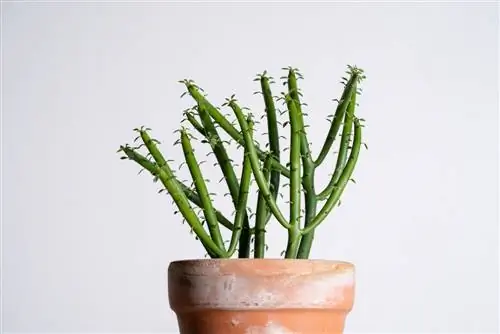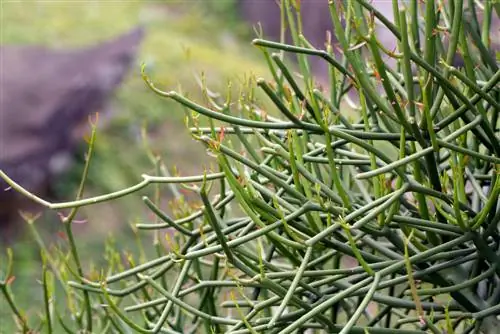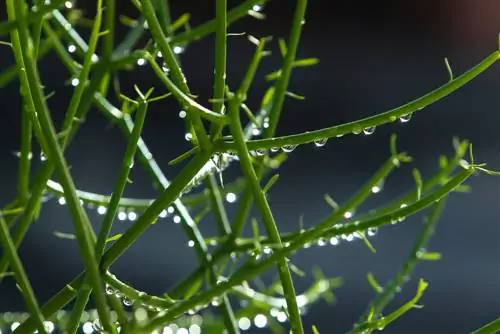- Author admin [email protected].
- Public 2023-12-16 16:46.
- Last modified 2025-06-01 06:02.
Read a commented pencil bush profile here with information about its bizarre growth and toxicity. Tips worth reading about the correct Euphorbia tirucalli care in the pot.

How do you care for a pencil bush?
The pencil bush (Euphorbia tirucalli) is a poisonous, succulent plant that is cultivated as a houseplant. Care includes a sunny location, slightly acidic, well-drained substrate, moderate watering, occasional fertilizing and pruning when necessary. Different varieties are characterized by their special shoots and colors.
Profile
- Scientific name: Euphorbia tirucalli
- Family: Spurge family (Euphorbiaceae)
- Genus: Spurge (Euphorbia)
- Origin: Madagascar, East and South Africa
- Growth type: succulent shrub
- Growth habit: bizarre, bushy-upright
- Growth height: 5 m to 7 m (in habitat)
- Leaf: tiny, linear
- Flower: inconspicuous
- Toxicity: highly toxic
- Winter hardiness: not hardy
- Use: Houseplant
Growth
The pencil bush is a subtropical plant species from the spurge family (Euphorbiaceae). Euphorbia tirucalli originally comes from Madagascar, East and South Africa. The exotic succulent has been a popular houseplant in this country for many years. The trade name pencil bush is an apt allusion to this extravagant growth:
- Growth type: evergreen shrub or small tree with succulent branches, tiny leaves and inconspicuous flowers.
- Growth habit: upright, bushy-bizarrely branched with shoots as thick as a pencil.
- Growth height in the habitat: 500 cm to 700 cm.
- Growth height in the pot: 60 cm to 80 cm, rarely up to 100 cm.
- Growth width in the pot: 30 cm to 40 cm, rarely up to 50 cm.
- Gardenically interesting properties: easy to care for, sensitive to frost, sun-hungry, poisonous, beautiful houseplant all year round.
Leaf
The foliage of a pencil bush makes no significant contribution to its bizarre, decorative appearance, as a look at these leaf features reveals:
- Leaf shape: elongated-linear
- Leaf length: 1 cm to 2.5 cm.
- Sheet width: 3 mm to 4 mm.
- Arrangement: alternate
Good to know: There is no reason to worry if the leaves fall off soon.
Bloom
In the subtropical home regions, a pencil bush develops small, yellow-green individual flowers from June to August. As a houseplant, the exotic spurge plant usually keeps its flowers under wraps.
Toxicity
The pencil bush is highly poisonous. As a typical plant species of the genus spurge, all parts of the plant are permeated by a toxic milky sap (Latin euphorbium) with these serious effects:
- Contact poison: corrosive substance causes excruciating skin irritation and painful inflammation of the eyes, mouth and nose. - Consumable poison: even small amounts trigger severe symptoms of poisoning, such as nausea, vomiting, diarrhea and even circulatory collapse.
- Irritating effect: up to 100,000 times more irritating than the capsaicin content of the hottest chili varieties.
Planting a pencil bush
You can buy a ready-to-plant Euphorbia tirucalli in specialist stores at any time of the year. Prices range between 4.99 euros for a 15-20 cm specimen and 99.90 euros for a fully grown pencil plant. Hobby gardeners can propagate a pencil bush easily and cheaply using cuttings. Important details determine perfect substrate quality, optimal site conditions and expert planting technology. You can read how to properly plant a pencil bush here:
Substrate
The right pencil bush substrate is low in nutrients and loose-drained with a pH value of 6.5 to 7.0. You can buy high-quality succulent soil or mix it yourself:
- 60 percent cactus soil
- 20 percent expanded clay or Seramis
- 20 percent quartz sand
Hobby gardeners with their own compost heap choose this succulent soil:
- 30 percent leaf compost (sifted and disinfected in the oven before use)
- 30 percent coconut soil (as an environmentally friendly peat substitute)
- 20 percent lava granules
- 20 percent pumice gravel or sand
Propagate
Head cuttings of a succulent Euphorbia tirucalli form roots very easily. The following short instructions explain the correct procedure:
- The best time to propagate cuttings is in spring.
- Put on gloves to protect yourself from the toxic latex.
- Cut cuttings with a length of 10 cm to 15 cm.
- Let the interfaces dry for two days.
- Fill 10 cm pots with the recommended succulent substrate.
- Push the cuttings half to two thirds of their height into the soil and water.
The first roots will form within three to four weeks in a bright to partially shaded, warm window seat. Successful rooting can be recognized by a fresh shoot.
Planting Tips
Skillful planting is based on the right combination of species-appropriate succulent soil, appropriate pot size and conscientious planting technique. Read the best planting tips for a pencil bush in top shape here:
- The pot is the right size if there is two finger-widths of space between the root ball and the edge of the container.
- A finger-thick drainage made of expanded clay on the bottom of the bucket prevents waterlogging.
- The planting depth in the bucket corresponds to the planting depth in the propagation pot and purchase container.
- The pencil plant is fertilized for the first time two months after planting at the earliest.
Location
These are the most important location preferences for a magnificent pencil bush with a WOW effect:
- Full sun to sunny location, preferably on the south window.
- During the summer from temperatures of 16° Celsius, please stay in the rain-protected spot on the balcony in full sun.
- Extra tip: a 14-day acclimatization period in a partially shaded location effectively prevents sunburn.
Excursus
The five best houseplants for beginners
Easy-care pencil bush (Euphorbia tirucalli) fits seamlessly into the ranking of the best houseplants suitable for beginners. The top 5 is led by arched hemp (Sansevieria cylindrica). The picturesque spider plant (Chlorophytum comosum) takes second place. The floral bronze medal goes to the majestic window leaf (Monstera), closely followed by the Christmas cactus (Schlumbergera). So far the pencil tree is content with fifth place. The following video introduces you to the good-natured houseplants in more detail:
Care for pencil bush
In the right location, a pencil bush is easy to care for. Gloves are mandatory for all care work. These care tips get to the heart of what is also important:
Pouring
- Water pencil bush evenly from spring to fall.
- Moisten substrate that is noticeably dry, but do not soak it.
- Ideally water with rainwater or stale tap water.
- Moisture meter in the substrate prevents waterlogging and ball dryness.
Fertilize
- Fertilize pencil bush sparingly from March to September.
- Add liquid succulent fertilizer (€7.00 on Amazon) to the irrigation water every 8 to 12 weeks
Cutting
- Pencil plant pruning only if necessary.
- Best appointment is during the sap rest period.
- Cut overly long, bent or unfavorably growing shoots with sharp, disinfected bypass scissors.
- Place the scissor blades just above a leaf or an eye.
- Stop flowing milky juice with a cotton swab.
Wintering
- Put Euphorbia tirucalli into winter quarters from October to February.
- Very bright and cool overwinter at at least 2,000 lux and 14° to 20° Celsius.
- Watering more sparingly without the root ball drying out.
- Do not fertilize the pencil bush in winter quarters.
Repotting
- Repot pencil bush every three to four years.
- The best time is in spring.
- Cut off any visibly diseased or dead roots from the potted, substrate-free ball.
Diseases, pests, care errors
A well-cared for pencil bush is immune to all kinds of pathogens thanks to its poisonous milky sap. If the African spurge plant is weakened by care errors, cunning pests take advantage of the opportunity. The following table draws attention to common malfunctions, their causes and effective countermeasures:
| malicious image | Cause | What to do? |
|---|---|---|
| Green or dark pests | Aphids | shower, spray soap-spirit solution |
| Bright webs, silver speckles | Spider mites | shower, increase humidity |
| Floppy shoots | Waterlogging | repotting, watering more sparingly |
| Brown spots after cleaning out | Sunburn | acclimatize in partial shade |
| Pale colors, stunted growth | Lack of light | place in a sunny location |
| Wrinkled shoots | Drought stress | dip, water more often from now on |
Popular varieties
Color comes into play with these beautiful pencil bush varieties:
- Sticks on Fire: blazes with a play of colors from reddish-yellowish branches.
- Rosea: inspires with fiery red shoots with a unique long-distance effect.
- Colorful pencil bush (Euphorbia tirucalli stramineus): Rarity, whose strong green shoots have bright orange and red tips.
FAQ
How to propagate a pencil bush?
The easiest way to propagate a pencil bush is through cuttings. Take 6-inch (15 cm) head cuttings in early spring with gloved hands. On the mother plant, inhibit the flowing milky sap with cotton pads. Leave the cuts on the cuttings to dry for two days. Now plant each cutting in a pot with low-nutrient cactus soil. New roots will form within a few weeks in a partially shaded, warm location.
Is the pencil bush poisonous?
The pencil bush is a highly poisonous spurge plant. A corrosive milky sap in all parts of the plant is responsible for its status as a poisonous plant. Unprotected contact with the skin or mucous membranes causes painful irritation. After intentionally or unintentionally consuming small quantities, there is a risk of significant symptoms of poisoning, such as nausea, vomiting and cramps. Euphorbia tirucalli should always be kept out of the reach of children and pets. Wearing gloves is mandatory for planting and care work.
Does a pencil bush grow hanging?
The real pencil bush is an African spurge plant with the botanical name Euphorbia tirucalli. The hallmark of this extravagant houseplant is its upright growth with bizarrely branched, pencil-thick shoots. The coral cactus (Rhipsalis cashero) from the cactus family (Cactaceae) is more suitable for hanging baskets. Its pencil-round shoots, up to 150 cm long, dangle casually from the hanging pot.
What is important in pencil bush care?
The decisive factor in pencil bush care is that the potting soil is highly permeable to water. Additives such as expanded clay, lava granules or quartz sand make a significant contribution to ensuring that excess irrigation water can drain away quickly. Waterlogging in the substrate inevitably leads to rot on the roots.






